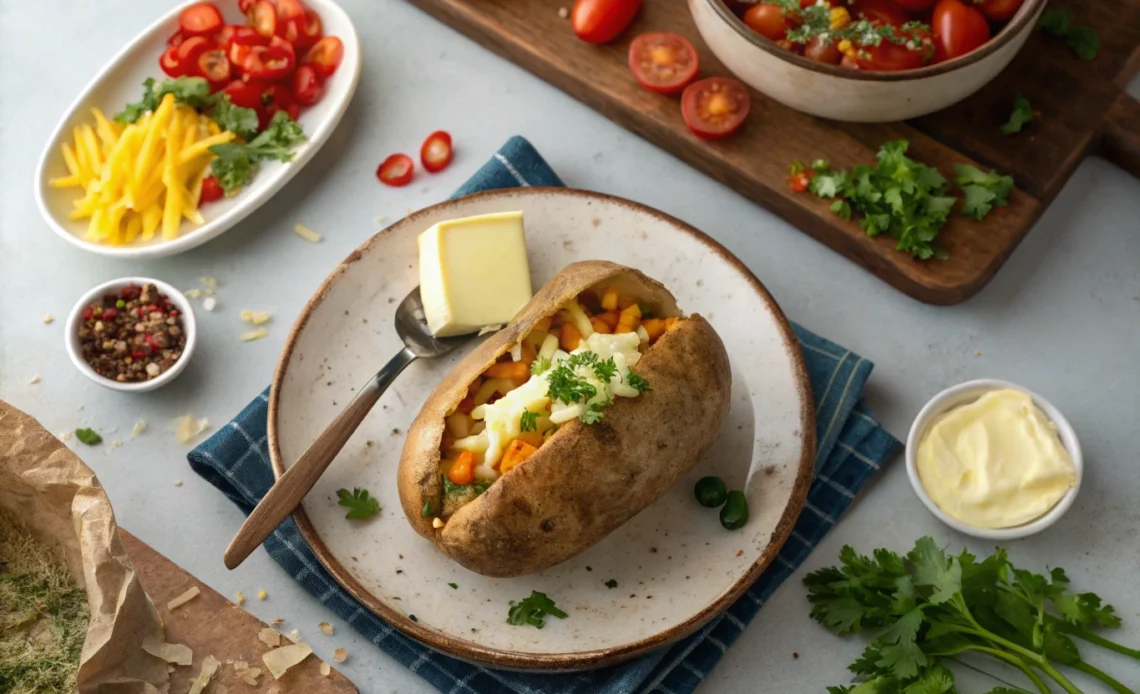
ANNONCE
The Rise of Kumpir in Turkish Street Food Culture
Table of Contents
ANNONCE
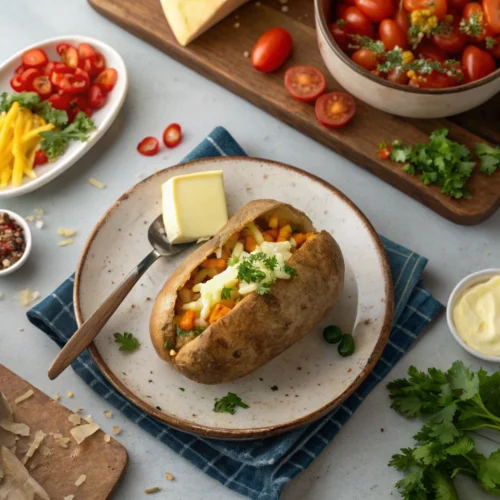
Kumpir: Turkish Stuffed Baked Potato
Equipment
- Oven
- Aluminum Foil
Ingredients
Base
- 2 large baking potatoes scrubbed clean and pierced with a fork
- 2 tbsp butter
- 60 g kaşar cheese or mozzarella, grated
Toppings
- corn
- peas
- black olives sliced
- green olives sliced
- pickled red cabbage
- sausages sliced
- Russian salad optional
- spicy bulgur salad kısır
Instructions
- Preheat the oven to 200°C (392°F). Wrap the scrubbed and pierced potatoes in aluminum foil and place in the oven.
- Bake the potatoes for 60–90 minutes until tender inside and crispy outside.
- Remove from oven, make a slit on top and fluff the interior with a fork.
- Add 1 tablespoon of butter and 30g of grated cheese per potato. Mix until creamy.
- Top with your favorite ingredients such as corn, olives, sausages, and salad.
- Serve hot and enjoy your stuffed baked Kumpir!
Notes
I still remember the first time I had kumpir. My neighbor Rosa, a warm-hearted woman from Mexico who had lived in Istanbul for a few years, invited me over for dinner. As she opened the oven, the savory aroma of baked potatoes filled the air. “You’re going to love this,” she said, spooning buttery, cheesy mash back into the crispy potato skin and covering it with colorful toppings. I was hooked.
Kumpir has become a cherished staple in Turkish street food, especially in tourist hotspots like Ortaköy in Istanbul. Its versatility and indulgent flavors make it a crowd-pleaser for all ages. Vendors set up carts filled with dozens of toppings, letting customers create their perfect stuffed baked potato. The experience is not just culinary but communal.
With street food growing in popularity around the world, kumpir stands out for its simplicity, adaptability, and heartwarming presentation. Whether enjoyed as a quick snack or a fulfilling meal, its charm lies in its interactive nature. Much like choosing a bowl at a salad bar, building a kumpir is about making something your own.
ANNONCE
So why has it become such a phenomenon? Let us explore.
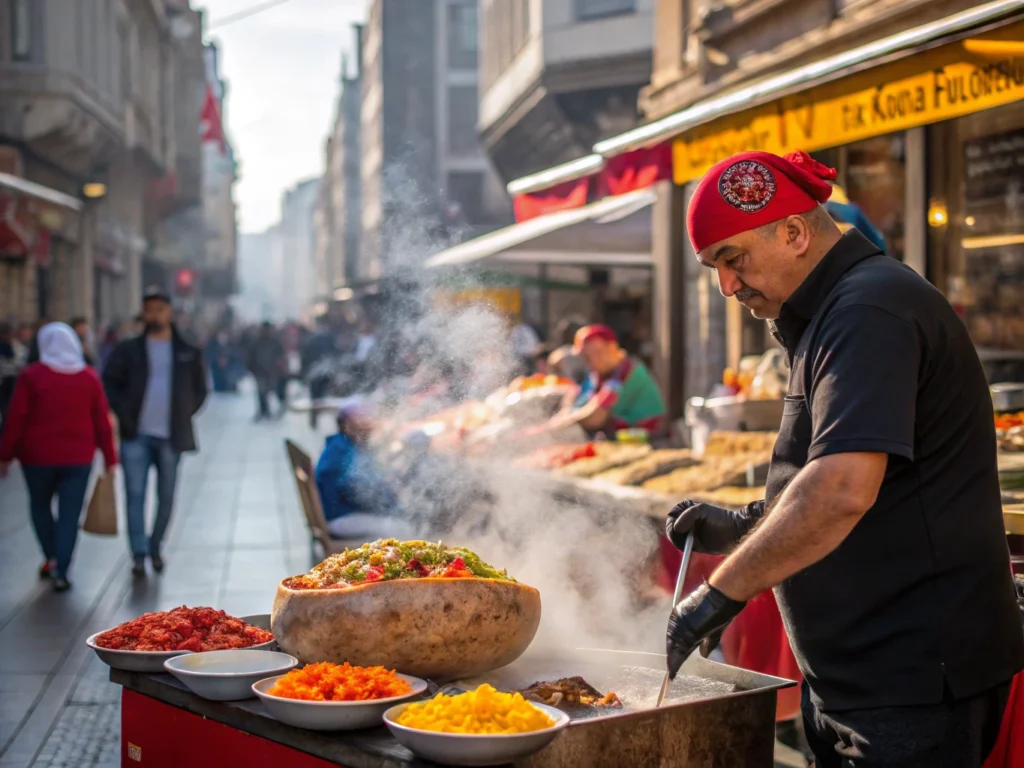
Defining Kumpir: More Than Just a Baked Potato
Kumpir may appear to be just a baked potato, but it is much more nuanced. The potato is baked until the skin becomes crisp and the interior fluffy. Then, while still piping hot, it is split open and mixed with generous amounts of butter and kaşar cheese, a mildly salty Turkish cheese known for its excellent melting qualities.
This results in a creamy, savory mash nestled inside its crisp shell. Unlike the plain baked potatoes found in Western cuisine, kumpir takes on a starring role, enhanced by an impressive array of toppings, including olives, corn, sausages, pickles, bulgur salad, and even Russian salad.
It is a dish that reflects Turkey’s rich and diverse culinary culture. Much like how a taco tells a story in Mexico or a samosa carries history in India, a kumpir is more than its ingredients. It is an expression of taste, history, and identity, brought together in a single, humble potato.
ANNONCE
Origins and Evolution of Kumpir in Turkey
While many associate kumpir with modern-day Istanbul, its roots go deeper. It likely evolved from regional traditions of stuffing vegetables and baking them—a hallmark of Turkish home cooking. The introduction of the potato to Ottoman cuisine occurred during the late 19th century, and from there, dishes like kumpir began to emerge.
Historically, potatoes were seen as peasant food, filling and inexpensive. But with Turkey’s rapid urbanization in the 20th century, food vendors began experimenting with ways to turn these basic staples into attractive street fare. The concept of serving a loaded baked potato gained traction in the 1980s and 1990s in Istanbul, especially near the Bosphorus.
Ortaköy, in particular, became the epicenter of kumpir culture. Vendors would line the waterfront, each offering endless toppings and personalized versions of the dish. Tourists and locals alike flocked to the area, eager to build their own edible creations. Today, kumpir remains an icon of Turkish street food, a testament to its enduring appeal and adaptability.
Kumpir’s Journey Across the Balkans
The popularity of kumpir did not stay confined within Turkish borders. Over time, it made its way across the Balkans, especially into countries like Bulgaria, Serbia, and Bosnia. Due to centuries of Ottoman influence in these regions, Turkish cuisine left a lasting mark.
ANNONCE
In these countries, you might find slight variations in toppings or cheeses used. In Serbia, for instance, sour cream or kajmak (a dairy product similar to clotted cream) might be added. In Bosnia, pickled vegetables and spicy sauces may reflect local preferences.
What is remarkable is how this dish has been embraced and localized. Its journey mirrors the movement of people, tastes, and traditions. Kumpir has managed to remain flexible enough to integrate into various cultures while still retaining its Turkish core.
The shared love for comfort food makes kumpir a bridge across borders, uniting people through its humble ingredients and heartwarming flavors.
Selecting the Right Potato: The Foundation of Kumpir
The success of any kumpir starts with the potato. Not just any variety will do. The ideal potato must have a firm structure and high starch content to yield that fluffy interior when baked. In Turkey, sebago or similar large, oblong types are preferred.
ANNONCE
The potato must be large enough to accommodate generous fillings and toppings. It should also bake evenly, with a skin sturdy enough to hold up against the pressure of mashed interior and multiple ingredients.
The preparation begins with a thorough cleaning. Dirt must be scrubbed off, and the skin dried to encourage crisping in the oven. Some vendors add a touch of olive oil or salt to the skin before baking, enhancing flavor and texture.
Just like choosing the right flour for bread or the right meat for a stew, the base of kumpir demands thoughtful selection. Everything that follows builds on this foundation.
Essential Ingredients: Butter, Cheese, and Beyond
Once the potato is baked to perfection, it is split open and the steaming interior is fluffed with a fork. At this stage, butter and cheese are added. The heat melts both ingredients, creating a creamy, savory mixture.
ANNONCE
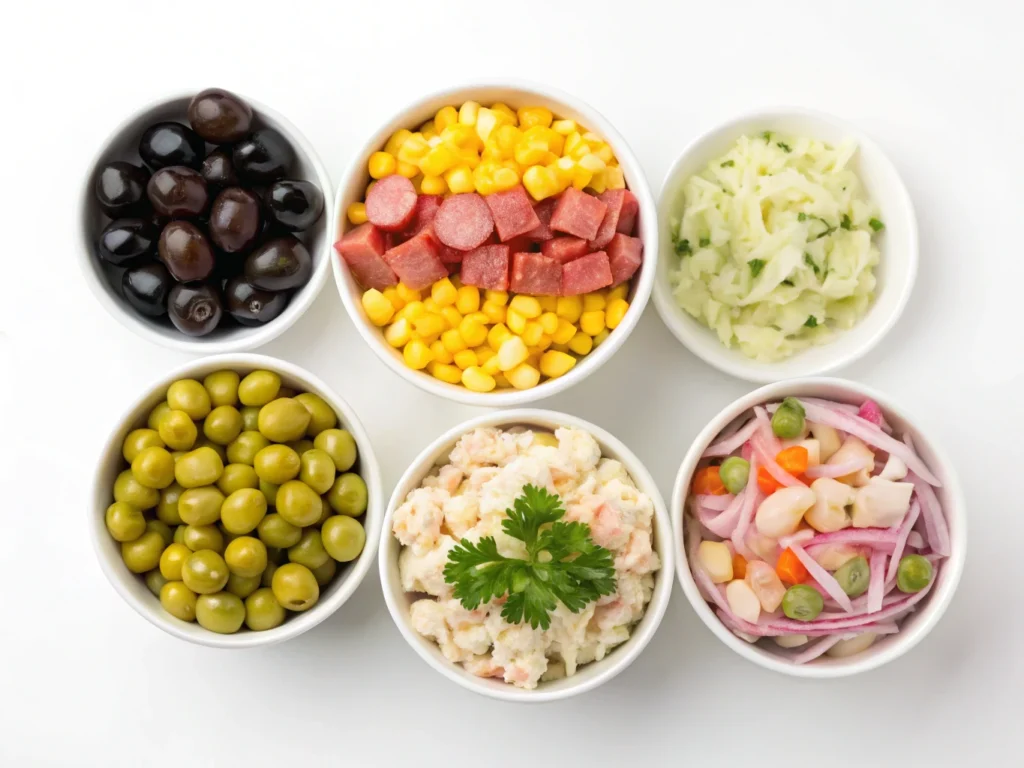
Kaşar cheese is the traditional choice, but mozzarella can be substituted in other regions. The butter must be unsalted and fresh, preferably from a local dairy. Together, these create the velvety base that defines a classic kumpir.
But the story does not end there. The true magic of kumpir toppings lies in the vast possibilities:
- Sliced black or green olives
- Sweetcorn
- Diced pickles
- Grated carrots
- Russian salad (a mayo-based veggie mix)
- Cooked sausages or sliced salami
- Spicy bulgur salad (kısır)
- Red cabbage
This variety makes kumpir a customizable dish, allowing for creativity and personal expression.
Step-by-Step Guide to Preparing Authentic Kumpir
Preparing kumpir at home is both enjoyable and satisfying. Here is a clear and detailed step-by-step method:
ANNONCE
- Select large baking potatoes and scrub them clean.
- Pierce each potato with a fork a few times to allow steam to escape.
- Wrap in aluminum foil for an even cook and place in a preheated oven at 200°C (392°F) for 60-90 minutes.
- Once baked, remove from oven and make a lengthwise slit across the top.
- Fluff the inside with a fork, and add 1 tablespoon of butter and a handful of grated kaşar cheese.
- Mix thoroughly inside the skin until smooth and creamy.
- Add toppings of choice, pressing them gently into the mashed potato.
And there you have it: authentic kumpir, ready to enjoy.
Classic Toppings: From Corn to Olives
Traditional toppings for kumpir vary slightly by vendor but commonly include:
- Corn
- Peas
- Green and black olives
- Pickled red cabbage
- Sliced sausages
- Spicy red pepper paste
- Grated cheese

These ingredients are laid out buffet-style, giving customers the power to personalize. This sense of ownership over flavor combinations is a big part of kumpir’s appeal.
Regional Variations: How Kumpir Differs Across Turkey
In the eastern cities like Gaziantep, spices and pastes add a more intense flavor. In coastal towns, seafood options sometimes appear. Each region infuses local culture into the dish.
ANNONCE
This makes kumpir variations a mirror of the country’s cultural diversity. It evolves while staying true to its origins.
Modern Twists: Innovative Toppings and Fusion Styles
Today’s chefs experiment boldly:
- Vegan versions with tahini sauce
- Fusion styles with Korean kimchi
- Mediterranean renditions with feta and olives
The possibilities are endless, keeping kumpir relevant in modern gastronomy.
Caloric Content and Nutritional Breakdown of Kumpir
| Ingredient | Calories (approx.) |
| Large potato | 250 |
| Butter (1 tbsp) | 100 |
| Cheese (30g) | 120 |
| Toppings (avg.) | 150-200 |
Total: 620-700 calories depending on toppings.
ANNONCE
Despite its indulgence, it can be made healthier with fresh veggies and controlled cheese.
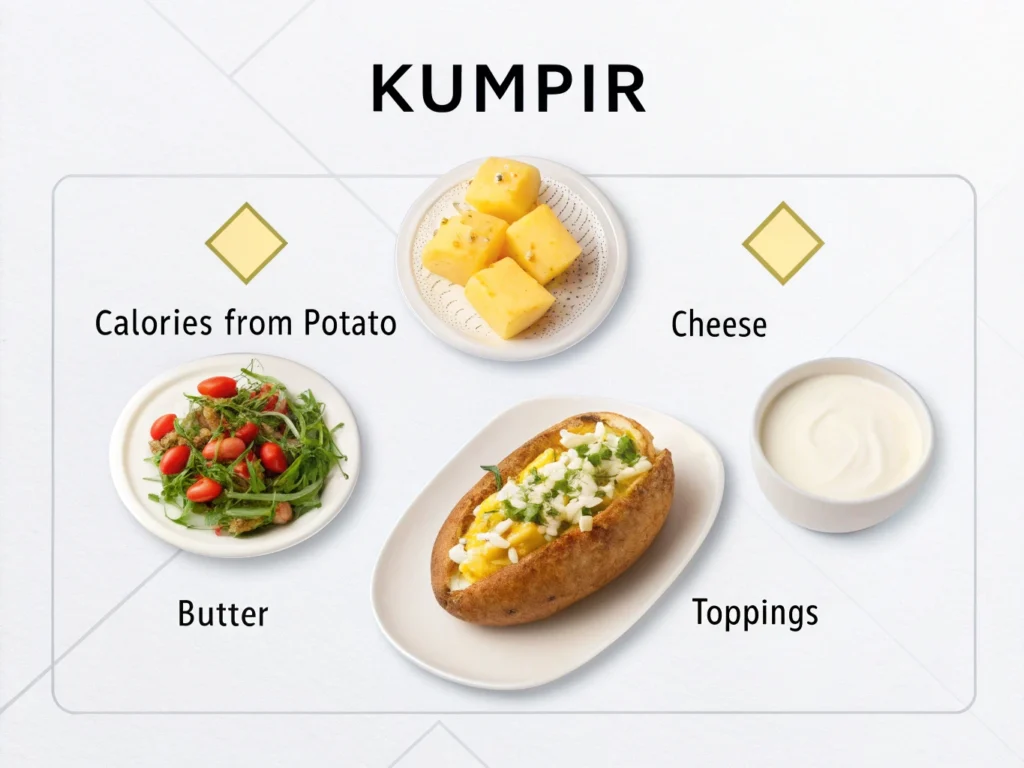
Adapting Kumpir for Vegetarian and Vegan Diets
Vegetarians can enjoy kumpir with ease. Cheese, veggies, and bulgur make it flavorful. Vegans can swap butter for olive oil and cheese for plant-based alternatives.
Kumpir is as inclusive as it is delicious.
Gluten-Free and Allergen-Friendly Options
Potatoes are naturally gluten-free. Those with allergies should check toppings carefully. Homemade kumpir preparation allows full control.
ANNONCE
Kumpir’s Influence and Presence Beyond Turkey
Kumpir has appeared in Europe and the Middle East. Its street-food friendly nature makes it easy to adopt.
Global food trucks and Turkish restaurants now feature it. Kumpir global influence is growing steadily.
Comparisons with Similar Dishes Worldwide
Kumpir is often compared to:
- Loaded American baked potatoes
- British jacket potatoes
- Mexican papas rellenas
Each offers its own spin, but kumpir’s creamy base and variety of toppings set it apart.
ANNONCE
Necessary Equipment and Ingredients
All you need:
- Oven
- Aluminum foil
- Large potatoes
- Butter, cheese, and toppings
Nothing fancy. Just good food, made simple.
Detailed Recipe with Step-by-Step Instructions
(Already included above)
Tips and Tricks for Perfecting Homemade Kumpir
- Bake slowly for creamy texture
- Fluff immediately after baking
- Use a wide range of toppings for balance
- Serve immediately to maintain texture
What to Put in a Kumpir?
Whatever you like! Popular items include corn, peas, Russian salad, pickles, sausages, and bulgur.
ANNONCE
What Is the Origin of Kumpir?
It originated in Turkey, especially popularized in Istanbul’s Ortaköy district.
Do You Eat the Skin of Kumpir?
Yes! The skin is edible, crispy, and nutritious when baked.
What Is Chicken Kumpir?
A version that includes grilled or shredded chicken as a topping, often combined with sauces or cheese.
The Enduring Appeal of Kumpir in Culinary Traditions
Kumpir is comfort food. It adapts, evolves, and delights. Its warmth goes beyond taste—it’s a dish that brings people together.
ANNONCE
Encouragement to Explore and Customize Kumpir Recipes
Do not hesitate to experiment. Let your imagination fill that potato. Make it yours, and enjoy the journey.

